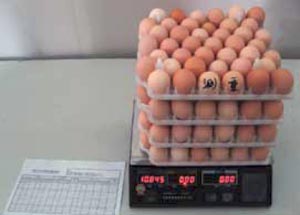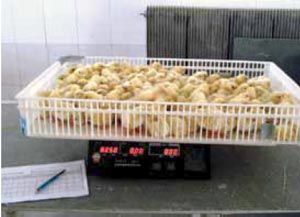



Investigating Hatchery Practice - Monitoring Egg and Chick Weights
In the third article of this series, Dr Steve Tullett, consultant for Aviagen specialising in incubation and fertility, explains the importance of monitoring egg and chick weights during incubation. The article forms part of a recently published Ross Tech publication, Investigating Hatchery Practice.Egg Weight Loss to 18 Days
The average chicken egg has about 10,000 pores running through the shell so the developing embryo can exchange oxygen and carbon dioxide with the incubator air. However, water is also lost through these pores and the total amount lost during incubation has to be controlled if the embryo is to avoid dehydration. This is most easily done by monitoring the weight loss of eggs during incubation. Any weight loss is due solely to the loss of water from the egg.

Observations across all avian species have shown that the weight loss between the start of incubation and pipping of the eggshell (i.e. approximately the time of transfer to the hatcher in the domestic fowl) is about 12 per cent of the fresh egg weight. The only way in which hatcheries can influence the weight loss from eggs is by altering the humidity in the incubator. Chick quality and hatchability can only be optimal when the eggs lose about 12 per cent of their fresh egg weight to pipping.
Hatcheries normally do not know the fresh egg weight, but commonly weigh the eggs just before setting. If the eggs have been stored for a short period (up to six days) under good conditions then the correct egg weight loss to pipping is 11.5 per cent of the egg setting weight. The optimal weight loss as a percentage of the egg setting weight is determined by the weight loss in storage.
The percentage egg weight loss should be measured by weighing whole trays of eggs (Figure 21). Accurate electronic scales are relatively cheap and using them to monitor weight loss from trays of eggs in various locations in all the setters is an invaluable way to check that eggs are receiving the ideal humidity conditions. The use of this method helps check that the humidity programmes and humidity control systems are working in all the setters and is thus an essential management tool in the hatchery.
Monitoring Chick Yield

Monitoring the weight of the chicks, and their relationship with the weight of the eggs they came from (chick yield) is another essential hatchery management tool. It is best done using the trays where egg weight loss has already been monitored. The technique involves counting and then weighing in bulk the Grade-A chicks from a hatcher tray (Figure 22) in order to calculate an average chick weight and then the chick yield. Chick yield is the average chick weight divided by the average fresh egg weight multiplied by 100. An ideal target for best chick quality is a chick yield of 67 per cent of the fresh egg weight or 67.5 per cent of the egg setting weight when the eggs have been exposed to short-term storage.
If egg weight loss to pipping has been correct, but the chick yield is lower than 66 per cent of the fresh egg weight, then incubation duration is too long. It needs to be adjusted by setting eggs later or by pulling chicks earlier. Every one per cent loss in chick yield is equivalent to about three hours extra in the hatcher.
If the chicks face a long journey before placement or are being transported in hot conditions then the chick yield could be increased to 69 to 70 per cent by increasing the setter humidity and/or taking the chicks out of the hatchery slightly early.
Further Reading
| - | You can see other articles in this series Investigating Hatchery Practice by clicking here. |
January 2010









